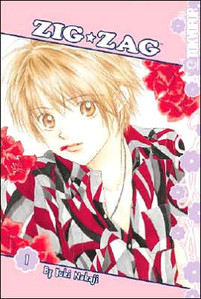Review
by Casey Brienza,Zig·Zag
GN 1-2
| Synopsis: |  |
||
Takaaki “Taiyou” Asakura's father has been transferred to Okinawa, but Taiyou is unable to contemplate of leaving behind his long-held, secret crush Marika, who taught him to love flowers. And so instead he decides to live on his new high school's campus, moving into Seifu Private Academy's Kazami Dormitory, where he shares a room with the remote Sonoh Kirihara…who just happens to be the reluctant heir apparent to a prominent ikebana (art of flower arrangement) family. Because he has more or less run away from home, the very last thing Sonoh wants to do is be reminded of his duty by his roommate. But of course, Taiyou's enthusiasm soon becomes infectious. After all, a boy who loves flowers and a boy who can't wait to get away from them? Must be fate! |
|||
| Review: | |||
Japan will never get tired of churning out romantic comedies set in boarding schools. It's a tried and true genre to which young readers can readily relate. But really now—let's be reasonable. A romantic comedy starring two boys who love ikebana? Surely mangaka Yuki Nakaji (also creator of Venus in Love) and her punch-drunk editors could have come up with a better title than Zig·Zag? One suspects rather that it was chosen at random for no reason in particular, given that over the course of two volumes, Nakaji offers no explanation for it in any of the sidebars or omake. Her cats and her costume jewelry collection are far more important, apparently. The plot, of course, offers no explanation for the title either. Come to think of it, the plot does not do much of anything, so this should not come as a surprise. The first volume focuses on settling in and setting the stage; we meet and get to know both starring boys, Taiyou's friend TATSUKI, their dorm leader Jin, and two girls, the tomboyish Saho and the timid Mei. Mostly, Taiyou gets used to his new school life and his remote roommate Sonoh, who peevishly divides their shared room in half with scotch tape on their first day. But he also ends up befriending Saho, whose athleticism and boyish behavior complements Taiyou's comparatively girlish appearance and effeminate interest in flower arranging. They bicker constantly, which naturally means they are destined for each other. Sonoh, for his part, is trying to free himself from the apron strings and the expectations that accompany being the eldest son. This last subplot, which could easily devolve into family melodrama, resolves a mite too quickly to be believed, however, at the beginning of volume two. In chapter five, Sonoh's twin brother Yuuki shows up with a ticket for one of their father's exhibitions. Sonoh does not want to go, but Taiyou, who has begun taking up ikebana in earnest, convinces him otherwise, and when he finally confronts his father, all he has to say is, “I'm going to choose my own road.” Two frames later, familial conflict appears to be permanently wiped from the picture. As if. The rest of the volume falls back on those school manga staples, the festival and the sports day. They give the series opportunity to further develop the characters, but the overarching narrative goes next to nowhere in the meantime. Which is a shame because, even with development, the characters are not all that special. Their personalities are flat and one-note, and any specificities they do evince are mined primarily for jokes. The stuff about Taiyou looking like a girl and him and Sonoh being a couple are cute, but it gets old very fast. Besides, we know that this manga is not boy's love (it was originally serialized in Hakusensha's shoujo magazine LaLa, home of Ouran High School Host Club, to name one other prominent title from the same time period), so the jokes will not ever become more substantial than lowbrow, vaguely homophobic humor. Ditto with the “Black” versus “White” Kirihara twins. It's all played for spectacle, not plot advancement. And like Zig·Zag's sorry excuse for character development, its artwork—standard, slightly messy shoujo fare that could originate from any of a thousand other mangakas' pens—also leaves something to be desired. For all that the girls swoon over the guys whenever the a chapter is in need of a panel or two of cheap comic relief, you would think they would be more handsome than they are. Unfortunately, art is not Nakaji's strong suit…but then, neither is anything else. Zig·Zag is as fluffy as a spray of baby's breath and as lightweight as a daisy petal. Tokyopop got its pastel pink and purple cover design scheme for the English-language edition pitch-perfect. It is hard, in short, to take seriously. However, it was not meant to be taken seriously, and the fact that it makes no pretense about its humble ambitions is the sole thing that truly recommends it. These two volumes by Yuki Nakaji are not the worst place to pursue transitory shoujo manga diversion, but they are by no means the best. |
|
The views and opinions expressed in this article are solely those of the author(s) and do not necessarily represent the views of Anime News Network, its employees, owners, or sponsors.
|
| Grade: | |||
Overall : C+
Story : C+
Art : B-
+ Lightweight shoujo entertainment with lots of pretty flower arrangements. |
|||
| Production Info: | ||
|
Full encyclopedia details about Release information about |
||